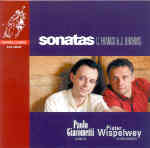Pieter Wispelwey’s performance of Franck’s A major Sonata is sure to raise some eyebrows. He plays the opening with utter simplicity, making the melody into sing-song and leaving pianist Paolo Giacometti to dote on the music’s rich harmonic details. It’s not that Wispelwey’s playing is inexpressive–the first movement builds to an intense climax–but his approach seems relatively serene compared to the surging and swaying of Mischa Maisky or Jacqueline Du Pré (both on EMI). Parts of the third movement seem to anticipate the dreamy clarity of Debussy’s music, and the finale effectively balances classical poise and romantic impulsiveness. Perhaps Wispelwey and Giacometti make less of the music’s sensuality than their rivals, but in their hands the sonata has a greater variety of emotion and texture.
Wispelwey begins the Brahms Sonata Op. 78 with similar efficiency. And again it makes you sit up and listen carefully. Is it too fast? Shouldn’t it seem more precious? I was tempted to say “yes”, until I remembered that Brahms marks the first movement Vivace ma non troppo–and vivace this most certainly is. Wispelwey maintains a fairly easy tone throughout, which not only helps to keep the textures clean (the sonata was written for the violin, after all), but allows Giacometti more room to play with color and shade.
In between the Franck and Brahms, Wispelwey and Giacometti offer Schumann’s Adagio and Allegro Op. 70 (originally for horn and piano). The cellist phrases the lyrical introduction very elegantly, and although the Allegro is played at a brisk tempo that no horn player could manage, the result is exhilarating. [11/16/2002]
































